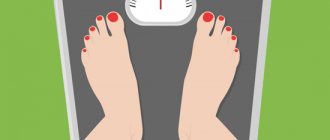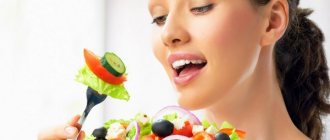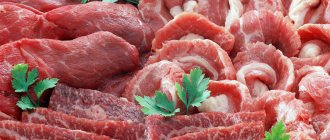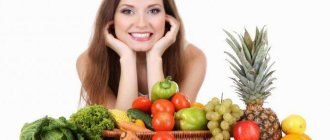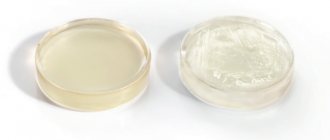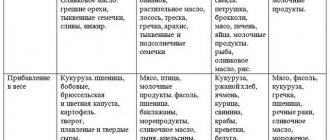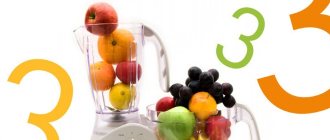Basic principles of proper nutrition during fasting
The mechanism of action is due to the replacement of food of animal origin with plant products.
Anything high in calories and difficult to digest is excluded. These include meat, fish, dairy products, eggs, as well as some types of high-carbohydrate cereals.
It is important not to confuse avoiding certain foods with fasting. The diet should be balanced and complete, rich in minerals, vitamins and protein.
A diet for fasting days involves frequent meals, from four times a day, but in small portions.
Alcoholic drinks, tobacco and sweets are completely excluded. Limited consumption of honey is acceptable.
It is important to drink enough water, depending on body weight - from 2 to 3 liters a day, this will help speed up metabolism and, as a result, get rid of excess weight.
Attention should also be paid to the fact that not all plant products are healthy.
Palm oil, which is widely used nowadays, although it is a plant product, the oils it contains have a structure that is difficult to digest and contribute to the formation of cholesterol plaques in blood vessels and obesity.
- During fasting, most of the fasting person's diet consists of carbohydrate foods, and very little protein is consumed. Meanwhile, protein is essential for human health; it is the “building material” of our body. Animal protein is excluded during fasting, but vegetable protein is allowed. Sources of vegetable protein - nuts, seeds, legumes, mushrooms, cereals, bread, soy products. Sea reptiles - shrimp, squid, mussels, etc., are also very rich in protein.
- If a person leads an active lifestyle, it is mandatory to eat foods that are a good source of energy and give a feeling of fullness for a long time - these are pasta, potatoes and cereals. But keep in mind that instant porridge is “fast” carbohydrates! This porridge quickly fills you up, but it also “burns” quickly, and after just a couple of hours you may feel hungry. Choose rolled oats with a cooking time of 15-20 minutes. If you don’t have time to cook in the morning, you can pour cold water over the rolled oats in the evening, and just heat the porridge in the morning.
- It is useful to season salads with olive oil, 1 tablespoon of oil per serving.
- Moderate consumption of dried fruits during fasting is beneficial - dried apricots, prunes, dates, and nuts. You can add them to your morning porridge or take them with you for a snack. Dried fruits and nuts are high in calories, so they fill you up quickly.
- Instead of sugar, use honey - you can add it to your morning porridge, tea, or use honey as a natural sweetener in baking. Dark chocolate, marmalade and dried fruits in moderation are preferable to sweet, lean flour products that can be found on store shelves. These foods tend to be high in fat, and consuming them can lead to weight gain.
- A very important principle of proper nutrition during fasting is the daily consumption of fresh and/or thermally processed vegetables and fruits. Vegetables and fruits are great for a snack - for example, if it is a vegetable salad (you can, if desired, diversify it by adding mushrooms, legumes, squid, nuts, croutons), seasoned with olive oil and 1 fruit.
- It is important not to starve and try to plan your meals so that there are no long breaks between meals. In this case, the digestive system will quickly and better adapt to a plant-based diet and the risk of such “troubles” as gastritis, constipation and indigestion will be reduced. For those people who follow the monastic rule, eating no more than 2 times a day, and observing days of complete abstinence from food, it is better to prepare in advance. Even before fasting, you should gradually reduce the frequency of meals to make it easier for the body to adapt to the new regime.
- If you are overweight, it is important to follow these rules to avoid gaining weight while fasting.
- First of all, it is necessary to minimize the amount of carbohydrate food in the evening meal. Since carbohydrates provide a lot of energy, and in the evening after school or work energy is usually not spent, it will be stored as fat “in reserve.” Therefore, in the evening it is better to give up pasta, potatoes, rice, cereals, flour products, bread and sweets. For dinner you can eat a variety of vegetable and legume dishes. These can be vegetable and bean salads, vegetable casseroles and cutlets, stews, vegetable caviar, baked and stewed vegetables, grilled vegetables, vegetable and bean soups (without potatoes, cereals and pasta). It is recommended to have dinner no later than 3-4 hours before bedtime! If you consider it obligatory to have a snack after dinner (for example, if dinner took place 5-6 hours before bedtime), then have a snack no later than 2 hours before bedtime.
- If it is acceptable for you to consume sea reptiles and soy products, you can also include them in your menu in the evening.
- On days when fish is allowed, an excellent dinner option would be fish or vegetables (except potatoes).
- In the evening, you can eat a few nuts with tea (not sweet). Sweets should be excluded for dinner.
- Eating potatoes is acceptable for lunch or breakfast, but not every day. Rice and pasta are preferred over potatoes. It is better to eat cereals for breakfast, fruits and dried fruits - before 7 pm. Diversify your diet with frequent consumption of vegetables, both raw and cooked.
- Pay attention to moderate consumption of vegetable oil - the most high-calorie product known!
- Eating a variety of soups is encouraged, both for lunch and dinner (for dinner, vegetable/bean soups without cereals, pasta and potatoes).
- Further, in the examples of the Lenten menu, you will see a mark (dietary breakfast/lunch/dinner), this means that this food option is suitable for people with excess body weight. On days of dry eating there is no such mark, since the diet on such days is itself dietary.
Review of the best diets
Options for a fasting diet have been developed, the difference being mainly in their duration. Everyone can choose a convenient type among existing interpretations, based on how many kilograms need to be lost in order to normalize weight without harm to health.
On porridge
A porridge diet is recommended for people with severe mental and physical stress. This diet helps increase endurance and provides the body with the right amount of carbohydrates.
It is necessary to regularly eat any porridge with water for breakfast. You can prepare oatmeal, wheat, buckwheat, and rice porridge. They also eat porridge for dinner, and lunch should be stewed vegetables.
Protein
The body can get proteins from plant foods. Given the fact that the body needs a certain amount of protein, the daily menu includes dishes made from plant-based foods rich in proteins. This diet can last from a week to a month.
Diet for quick weight loss
If you need to get rid of extra pounds in a short time, you should drink 2 liters of water and eat 2 apples for three days. As a result, up to 5 kg of weight is lost. Not everyone can follow such a nutritional program. During the fast diet period, you should limit exercise and sleep at least 8 hours a day.
Vegetable Lenten Diet
The diet involves eating exclusively vegetables and a small amount of fruit. You should have a fruit salad for breakfast, drink tea for lunch, and have baked vegetables and vegetable soup for lunch. For an afternoon snack, you can drink vegetable juice, and for dinner it is recommended to have a salad of vegetables and herbs.
Lenten cleansing diet
You can cleanse your body by following a specific diet plan for 2-3 weeks. You should have breakfast with boiled vegetables and herbs, drink plain coffee or unsweetened tea. You should have apple salad for lunch, and vegetarian cutlets for an afternoon snack. An option for dinner is pumpkin porridge with nuts and green tea.
Lenten soup diet
The duration of this diet is 14 days. It is important to eat only soups and vegetable broths without fat during the prescribed period, without consuming other foods. You can satisfy your hunger with vegetable broth.
Balanced
With a balanced diet, the menu should include products of plant origin containing fiber, protein and other useful substances. An approximate menu of one bottom, compiled according to this scheme, looks like this:
- Breakfast. 50g buckwheat porridge in water with fresh apple, a cup of coffee.
- Lunch. A handful of nuts and dried fruits.
- Dinner. Vegetable soup with herbs, lavash.
- Afternoon snack. Fresh fruit salad with a teaspoon of honey.
- Dinner. 100g oatmeal with a small portion of stewed cabbage, green tea.
How to eat healthy while fasting
The fasting diet includes restrictions on the foods you eat. Recommended ones include:
- cereals;
- vegetables, fruits, berries;
- mushrooms;
- nuts, dried fruits, candied fruits;
- honey, jam, compotes;
- pickles, pickled vegetables;
- spices, seasonings, herbs;
- legumes;
- vegetable oil.
The fasting diet allows you to eat fish three times and caviar on the last day for the entire period of observance. For the rest of the period, the following menu is recommended:
- on Mondays, Wednesdays and Fridays – dietary cold dishes without oil;
- Tuesday, Thursday - lean hot food without adding oil;
- Saturday, Sunday – food with butter, you can drink a little wine;
- Several days from the church calendar you need to fast and eat in the evening; they fall on the first and last week.
A simple and correct lean diet for weight loss includes fruit and vegetable dishes, which you don’t need to think about how to prepare. Sauerkraut, pickles, and mushroom preparations are ideal. You can make boiled, stewed dishes, use a grill, a double boiler, or a multicooker. The daily fasting diet involves short heat treatment of foods to preserve vitamins and nutrients.
We invite you to familiarize yourself with Morning exercises for weight loss at home for women: photo
The most important Lenten dish is porridge - cook it in water, without butter. To improve the taste, add lean additives to the cereals - fried onions with mushrooms for a savory dish and nuts and raisins for a sweet dish. If it is difficult to give up animal protein for almost two months, buy “soy meat” or tofu - chop it, simmer in sauce and spices. The dish will replace meat products in value and taste, and will be easy to prepare.
How much can you lose?
The more restrictions and refusals to indulge yourself in your favorite fast food and meat delicacies, the greater the result you will get. How much you can lose on a diet will depend as much as possible on the duration, strict adherence to the rules and responsibility to yourself. A complete rejection of fatty foods will speed up the process, and the body will begin to actively lose weight. Roughly given figures range from a kilogram to ten.

- Hearing aids for the elderly
- Treatment of vegetative-vascular dystonia
- How to quickly get rid of worms at home
Advantages and disadvantages
Even a week of a fast diet has a tangible positive effect on the entire body.
A well-designed diet allows you to achieve the following results in a short time:
- Reducing excess weight by reducing the total amount of calories consumed, unhealthy fats and so-called “fast” carbohydrates - these are almost all sweets; they account for most of the credit for increasing body fat.
- Cleansing the body of toxins due to the consumption of increased amounts of fiber, which promotes their removal, and the simultaneous rejection of harmful foods.
- Improving the cardiovascular system, reducing the risk of developing atherosclerosis and pathologies associated with excess cholesterol.
- Normalizing blood sugar levels, which serves as a good prevention of diabetes.
- Feeling better.
- Normalization of metabolism and digestive system.
For such people, you should add more foods high in carbohydrates - pasta, fruit, bread.
For actively involved in sports, fasting days are also a good way, without any changes for the rest of the period.
| pros | Minuses |
|
Advantages and disadvantages of a meatless diet
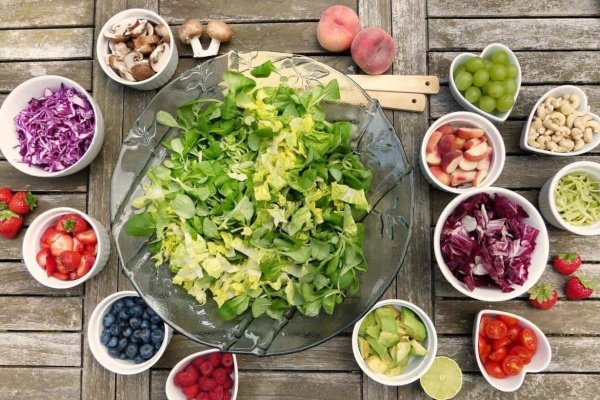
A fasting diet provides more than just weight loss benefits. It has a healing effect on the body:
- Reduces cholesterol;
- Cleanses the blood and intestines;
- Removes toxins and waste;
- Improves intestinal flora;
- Serves as a prevention of vascular diseases.
A long-term diet is recommended no more than once a year. And you can afford weekly ones 3-4 times a year.
The disadvantage of posts is that they are strictly limited. People involved in physical labor need high-calorie foods. During the 40-day diet, they can include more legumes in their diet, as well as fish. People with poor health should not adhere to strict fasting.
Authorized Products
Meals while fasting can be varied and tasty. Authorized products:
- lean bread, lavash;
- table vinegars, lean mayonnaise;
- ketchup, adjika;
- seaweed;
- nuts, seeds, honey;
- whole grain pasta and flour;
- dried fruits;
- cereals;
- mushrooms;
- legumes;
- on certain days fish, caviar, seafood, red wine;
- fruits, vegetables, marinades, pickles, berries;
- homemade jam, jam;
- lean chocolate;
- soy, coconut milk;
- herbal teas, jelly, compote, juices, fruit drinks, chicory;
- soy yoghurts, cheeses;
- vegetable oil;
- marshmallows without eggs, marmalade, Turkish delight, halva, kozinaki, lollipops;
- Korean salads.
When following a lean diet, strict restrictions are imposed. Prohibited products:
- meat dishes, poultry;
- milk, cheese, cottage cheese, dairy drinks;
- eggs;
- offal;
- fish dishes (except on certain days);
- flour baked goods;
- alcoholic drinks, coffee, fast food, candy.
The fasting diet for each day includes:
- Fresh and stewed vegetables, salads, vinaigrette. Cutlets made from carrots, cabbage, potatoes or mushrooms. In winter, frozen vegetables are used.
- Boiled legumes, soups with legumes, bean and pea pates.
- Soy products: milk, mayonnaise, cottage cheese.
- Vegetarian soups with vegetables, dumplings, mushrooms and cereals.
- Dumplings with potatoes, mushrooms or cabbage.
- Mushrooms, stewed or baked.
- Any cereals and pasta. Porridges are boiled in water, and vegetable oil is added to the finished ones.
- Various fruits and dried fruits.
- Pickles and pickles.
- Jams and jams.
- Whole grain bread, rye, bran bread. Pancakes, pita bread, pies, cooked with water and without eggs.
- Vegetable and fruit juices, infusions of herbs and fruits, compotes, mineral water, green tea with lemon, cranberry and other fruit drinks.
- Various types of nuts and seeds.
- Vegetable oil for adding to dishes (on certain days).
- Boiled or stewed fish of low-fat varieties (on certain days).
| Proteins, g | Fats, g | Carbohydrates, g | Calories, kcal | |
Vegetables and greens | ||||
| greenery | 2,6 | 0,4 | 5,2 | 36 |
| eggplant | 1,2 | 0,1 | 4,5 | 24 |
| beans | 6,0 | 0,1 | 8,5 | 57 |
| zucchini | 0,6 | 0,3 | 4,6 | 24 |
| cabbage | 1,8 | 0,1 | 4,7 | 27 |
| broccoli | 3,0 | 0,4 | 5,2 | 28 |
| boiled cauliflower | 1,8 | 0,3 | 4,0 | 29 |
| bulb onions | 1,4 | 0,0 | 10,4 | 41 |
| carrot | 1,3 | 0,1 | 6,9 | 32 |
| cucumbers | 0,8 | 0,1 | 2,8 | 15 |
| salad pepper | 1,3 | 0,0 | 5,3 | 27 |
| radish | 1,2 | 0,1 | 3,4 | 19 |
| white radish | 1,4 | 0,0 | 4,1 | 21 |
| red radish | 1,2 | 0,1 | 3,4 | 20 |
| black radish | 1,9 | 0,2 | 6,7 | 35 |
| salad | 1,2 | 0,3 | 1,3 | 12 |
| beet | 1,5 | 0,1 | 8,8 | 40 |
| celery | 0,9 | 0,1 | 2,1 | 12 |
| soybeans | 34,9 | 17,3 | 17,3 | 381 |
| asparagus | 1,9 | 0,1 | 3,1 | 20 |
| tomatoes | 0,6 | 0,2 | 4,2 | 20 |
| pumpkin | 1,3 | 0,3 | 7,7 | 28 |
| beans | 7,8 | 0,5 | 21,5 | 123 |
| garlic | 6,5 | 0,5 | 29,9 | 143 |
| lentils | 24,0 | 1,5 | 42,7 | 284 |
| spinach | 2,9 | 0,3 | 2,0 | 22 |
| sorrel | 1,5 | 0,3 | 2,9 | 19 |
Fruits | ||||
| avocado | 2,0 | 20,0 | 7,4 | 208 |
| oranges | 0,9 | 0,2 | 8,1 | 36 |
| bananas | 1,5 | 0,2 | 21,8 | 95 |
| pomegranate | 0,9 | 0,0 | 13,9 | 52 |
| grapefruit | 0,7 | 0,2 | 6,5 | 29 |
| pears | 0,4 | 0,3 | 10,9 | 42 |
| kiwi | 1,0 | 0,6 | 10,3 | 48 |
| lemons | 0,9 | 0,1 | 3,0 | 16 |
| tangerines | 0,8 | 0,2 | 7,5 | 33 |
| nectarine | 0,9 | 0,2 | 11,8 | 48 |
| peaches | 0,9 | 0,1 | 11,3 | 46 |
| apples | 0,4 | 0,4 | 9,8 | 47 |
Berries | ||||
| grape | 0,6 | 0,2 | 16,8 | 65 |
| gooseberry | 0,7 | 0,2 | 12,0 | 43 |
| Red currants | 0,6 | 0,2 | 7,7 | 43 |
| black currant | 1,0 | 0,4 | 7,3 | 44 |
Mushrooms | ||||
| mushrooms | 3,5 | 2,0 | 2,5 | 30 |
| frozen assorted mushrooms | 2,2 | 0,8 | 0,7 | 20 |
| fresh champignons | 4,3 | 1,0 | 1,0 | 27 |
| fresh milk mushrooms | 1,8 | 0,5 | 0,8 | 16 |
| fresh chanterelles | 1,6 | 1,1 | 2,2 | 20 |
| fresh oyster mushrooms | 2,5 | 0,5 | 6,2 | 34 |
| fresh boletus | 2,4 | 0,7 | 1,7 | 9 |
| fresh honey mushrooms | 2,2 | 1,2 | 2,8 | 17 |
| fresh saffron milk caps | 1,9 | 0,8 | 2,7 | 17 |
Nuts and dried fruits | ||||
| nuts | 15,0 | 40,0 | 20,0 | 500 |
| dried fruits | 2,3 | 0,6 | 68,2 | 286 |
| raisin | 2,9 | 0,6 | 66,0 | 264 |
| cashew | 25,7 | 54,1 | 13,2 | 643 |
| sesame | 19,4 | 48,7 | 12,2 | 565 |
Cereals and porridges | ||||
| buckwheat (kernel) | 12,6 | 3,3 | 62,1 | 313 |
| oat groats | 12,3 | 6,1 | 59,5 | 342 |
| corn grits | 8,3 | 1,2 | 75,0 | 337 |
| pearl barley | 9,3 | 1,1 | 73,7 | 320 |
| millet cereal | 11,5 | 3,3 | 69,3 | 348 |
| rice | 6,7 | 0,7 | 78,9 | 344 |
Flour and pasta | ||||
| pasta | 10,4 | 1,1 | 69,7 | 337 |
Confectionery | ||||
| jam | 0,3 | 0,2 | 63,0 | 263 |
| jam | 0,3 | 0,1 | 56,0 | 238 |
Raw materials and seasonings | ||||
| honey | 0,8 | 0,0 | 81,5 | 329 |
Cheeses and cottage cheese | ||||
| curd tofu | 8,1 | 4,2 | 0,6 | 73 |
Fish and seafood | ||||
| seaweed | 0,8 | 5,1 | 0,0 | 49 |
Oils and fats | ||||
| linseed oil | 0,0 | 99,8 | 0,0 | 898 |
| olive oil | 0,0 | 99,8 | 0,0 | 898 |
| sunflower oil | 0,0 | 99,9 | 0,0 | 899 |
Non-alcoholic drinks | ||||
| mineral water | 0,0 | 0,0 | 0,0 | – |
| green tea | 0,0 | 0,0 | 0,0 | – |
| black tea | 20,0 | 5,1 | 6,9 | 152 |
| * data is per 100 g of product | ||||
- All types of meat.
- Poultry meat.
- Smoked meats, sausages, canned food.
- Dairy products, including butter.
- Eggs.
- Animal fats.
- Fried foods.
- Baked goods containing eggs and dairy products, sweets, dough products, chocolate, ice cream, cakes.
- Alcoholic drinks.
| Proteins, g | Fats, g | Carbohydrates, g | Calories, kcal | |
Confectionery | ||||
| candies | 4,3 | 19,8 | 67,5 | 453 |
| pastry cream | 0,2 | 26,0 | 16,5 | 300 |
| cookie | 7,5 | 11,8 | 74,9 | 417 |
Ice cream | ||||
| ice cream | 3,7 | 6,9 | 22,1 | 189 |
Cakes | ||||
| cake | 4,4 | 23,4 | 45,2 | 407 |
Chocolate | ||||
| chocolate | 5,4 | 35,3 | 56,5 | 544 |
Raw materials and seasonings | ||||
| mayonnaise | 2,4 | 67,0 | 3,9 | 627 |
Dairy | ||||
| milk 3.6% | 2,8 | 3,6 | 4,7 | 62 |
| milk 4.5% | 3,1 | 4,5 | 4,7 | 72 |
| cream | 2,8 | 20,0 | 3,7 | 205 |
| sour cream 25% (classic) | 2,6 | 25,0 | 2,5 | 248 |
| natural yogurt 2% | 4,3 | 2,0 | 6,2 | 60 |
Cheeses and cottage cheese | ||||
| cheese | 24,1 | 29,5 | 0,3 | 363 |
| cottage cheese 11% | 16,0 | 11,0 | 1,0 | 170 |
| cottage cheese 18% (fat) | 14,0 | 18,0 | 2,8 | 232 |
Meat products | ||||
| pork | 16,0 | 21,6 | 0,0 | 259 |
| pork liver | 18,8 | 3,6 | 0,0 | 108 |
| pork kidneys | 13,0 | 3,1 | 0,0 | 80 |
| pork fat | 1,4 | 92,8 | 0,0 | 841 |
| salo | 2,4 | 89,0 | 0,0 | 797 |
| beef | 18,9 | 19,4 | 0,0 | 187 |
| beef liver | 17,4 | 3,1 | 0,0 | 98 |
| beef kidneys | 12,5 | 1,8 | 0,0 | 66 |
| beef brains | 9,5 | 9,5 | 0,0 | 124 |
| mutton | 15,6 | 16,3 | 0,0 | 209 |
| meat pate | 16,4 | 23,3 | 0,4 | 277 |
Sausages | ||||
| smoked sausage | 16,2 | 44,6 | 0,0 | 466 |
| smoked sausage | 9,9 | 63,2 | 0,3 | 608 |
| sausages | 10,1 | 31,6 | 1,9 | 332 |
| sausages | 12,3 | 25,3 | 0,0 | 277 |
Bird | ||||
| smoked chicken | 27,5 | 8,2 | 0,0 | 184 |
| chicken fillet | 23,1 | 1,2 | 0,0 | 110 |
| duck | 16,5 | 61,2 | 0,0 | 346 |
| smoked duck | 19,0 | 28,4 | 0,0 | 337 |
| goose | 16,1 | 33,3 | 0,0 | 364 |
Eggs | ||||
| eggs | 12,7 | 10,9 | 0,7 | 157 |
Fish and seafood | ||||
| fish | 18,5 | 4,9 | 0,0 | 136 |
| smoked fish | 26,8 | 9,9 | 0,0 | 196 |
| salted fish | 19,2 | 2,0 | 0,0 | 190 |
| canned fish | 17,5 | 2,0 | 0,0 | 88 |
| cod (liver in oil) | 4,2 | 65,7 | 1,2 | 613 |
Oils and fats | ||||
| animal fat | 0,0 | 99,7 | 0,0 | 897 |
| cooking fat | 0,0 | 99,7 | 0,0 | 897 |
| * data is per 100 g of product | ||||
We invite you to read Lazy oatmeal in a jar without cooking: breakfast recipes
For proper weight loss, you should know that during fasting you cannot eat products of animal origin - meat, fish, eggs, animal fat and milk. Low-fat dairy products, chicken and seafood are also prohibited. The fasting diet does not recommend eating too much bread and potatoes - this will lead to excess weight gain. It is allowed to take wine only on holidays according to the calendar, plus there is an exemption for taking fish and caviar.
https://www.youtube.com/watch?v=cvsyBEjHuPQ
Doctors warn that not everyone can fast and follow a strict eating regimen. Contraindications for fasting should be taken into account if you fall into the following categories:
- with chronic diseases;
- when doing hard work;
- pregnant, nursing mothers;
- children under 14 years of age;
- people who have recently suffered mental or emotional trauma or serious illness;
- rehabilitation process;
- ulcer, pancreatitis, gastritis;
- diabetes;
- renal failure.
Lenten pp nutrition
First, let's define what the difference is between lean nutrition and just proper nutrition.
- Firstly, a lean diet absolutely excludes any meat products, while a normal healthy diet only excludes fatty meats such as lamb, duck, and pork. All types of sausages, canned meat, pates, etc. are also prohibited during Lent.
- Secondly, during fasting there should also be no dairy products in your diet. Milk, cottage cheese, kefir, fermented baked milk, butter - all this is not included in the lean diet, although it fits perfectly into the framework of the usual paragraph.
- During fasting, it is allowed to eat fish, but not all the time. It can be included in the diet several times during major church holidays.
- You should also be careful when choosing sauces and seasonings. Many sauces contain milk or eggs, so their use is also prohibited.
- The basis of a lean diet is cereals, legumes, vegetables and fruits. And this is what unites this nutrition with the right one. In other words, a lean diet is very similar to a vegetarian diet, since the set of products is exclusively of plant origin.
At first glance, it may seem that such a set of products is quite enough for meals during Lent, but you shouldn’t get ahead of things
If in the first weeks of fasting your body can still cope with such serious restrictions, then in the middle or at the end of fasting the body is gradually depleted and it is important to include in your diet the right foods rich in nutrients, vitamins, and most importantly, proteins!
How to replace protein during fasting with pp?
- If you follow a healthy diet, then you can include protein in your diet. Only it must be lactose-free vegetable protein. Luckily, purchasing this supplement is not difficult. With this source of protein, you can prepare a lot of healthy Lenten recipes and control the ratio of BJU during fasting.
- Include legumes in your diet. If you haven't been a fan of beans, lentils and peas, you'll just have to during Lent because they're the perfect plant-based source of protein. 100 grams of beans contain about 20 grams of protein. In comparison, chicken contains 23 grams of protein, so beans are almost as good! Using legumes, you can prepare first and second courses and even bake delicious and low-calorie desserts!
- Don't forget about soy products. Soy and tofu cheese are your helpers and allies during fasting meals. With just 76 calories per 100 grams of tofu and 8 grams of protein, tofu sandwiches are your savior.
- Another salvation during fasting is nuts. They also contain a lot of proteins, but you should not overdo it, because, in addition to protein, this product contains a lot of fat, and if you adhere to pp, you must control the balance of BJU.
- Among vegetables, mushrooms should definitely be mentioned. So, 100 grams of dried porcini mushrooms (and they are most often consumed during fasting) contain as much as 100 grams of protein!
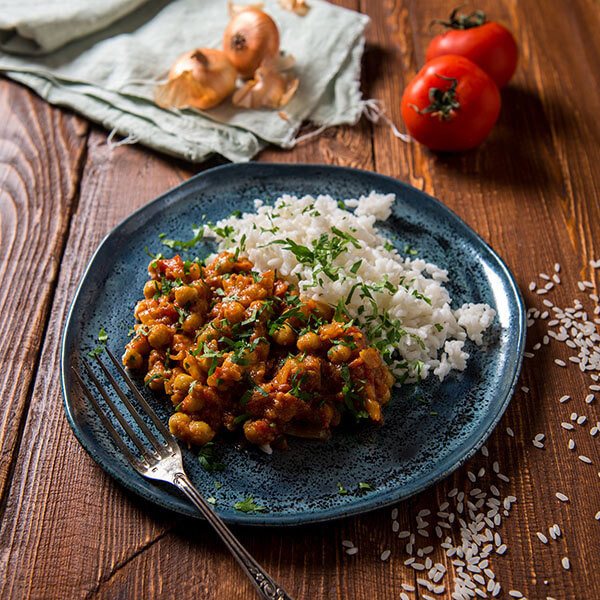
Options for different purposes
The frequency of application of the technique and the variety of recipes for a lean diet directly depend on the goals being pursued.
If for believers the list of permitted and prohibited products is strictly regulated by Christian customs, then atheists can afford some deviations.
Universal advice would be to take additional pharmacy vitamins. This does not contradict church canons, and will also help everyone else avoid the consequences of insufficient intake of vital elements into the body.
Nutritionist opinion
Most experts agree that with the correct preparation of the diet, the method has no contraindications and is suitable for absolutely everyone.
But they warn against inadequate intake of microelements and vitamins into the body.
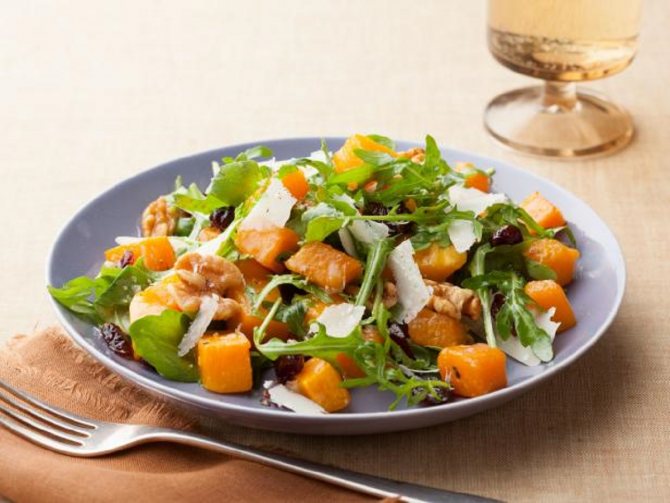
People in physical professions should pay special attention to calorie content.
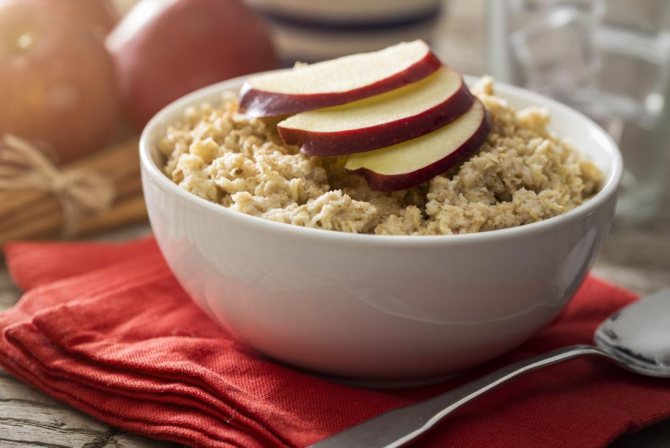
After all, if you are not an athlete in the pre-competition period, the meager energy value will lead to the opposite of the desired results, and can contribute to the development of a number of pathologies.

Therefore, do not be lazy to count calories, and monitor the condition of your body. At the slightest symptoms of excessive fatigue or nervous exhaustion, you should stop the diet.
Menu for Lent
According to church nutrition rules, food should be taken twice a day, but this regime is unlikely to be suitable for working people leading an active lifestyle. Moreover, it is not suitable for weight loss. A long break from eating less nutritious food will cause increased appetite and larger portions at dinner. In addition, at breakfast you will also try to eat more so that you “have enough” until the evening.
From a nutritional point of view, it is optimal to eat 3-4 times, but in small portions. A variety of lean foods helps create a varied menu. The diet for Lent should include as many vegetable dishes as possible, dishes made from legumes, mushrooms, soy products, cereals, muesli, unsweetened corn flakes and juices, which can serve as a main dish and as a snack.
It is difficult for a modern person to do without spices, so they can be added to vegetable dishes and soups, but in moderation. Below is an approximate diet for a week. If it is strictly observed, on Monday, Wednesday and Friday, dishes are prepared without vegetable oil, the remaining four days of the week - with oil.
Monday
| Breakfast |
|
| Dinner |
|
| Afternoon snack | |
| Dinner |
|
Tuesday
| Breakfast |
|
| Dinner |
|
| Afternoon snack | |
| Dinner |
|
| Breakfast |
|
| Dinner |
|
| Afternoon snack | |
| Dinner |
|
Thursday
| Breakfast |
|
| Dinner |
|
| Afternoon snack | |
| Dinner |
|
Friday
| Breakfast |
|
| Dinner |
|
| Afternoon snack | |
| Dinner |
|
Saturday
| Breakfast |
|
| Dinner |
|
| Afternoon snack | |
| Dinner |
|
Sunday
| Breakfast |
|
| Dinner |
|
| Afternoon snack | |
| Dinner |
|
This diet pattern can be repeated until the end of the fast. The exception is the last week, when abstinence from food is recommended on the Friday before Easter.
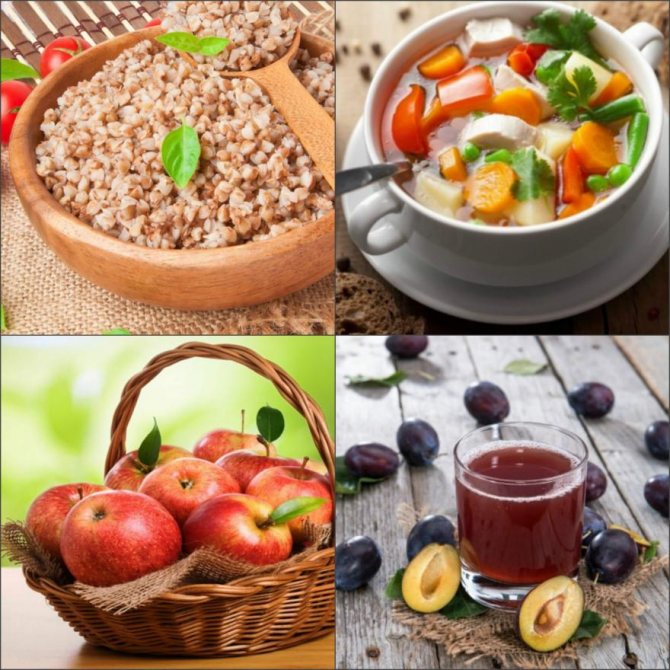
Nutritionists claim that Lent and fasting during it help you lose weight. To ensure that your diet during fasting every day brings positive results, follow the rules of the method:
- Include soy products, legumes, nuts, seeds, cereals, and wholemeal products in your diet.
- Pasta and potatoes should be eaten less frequently than other foods.
- Eat at least half a kilo of vegetables and fruits every day.
- Healthy options include brown rice, millet, buckwheat, soybeans, lentils, dates, bananas, and peanuts.
- To meet the body's need for vitamin B12 and iron, take complex dietary supplements.
- You need to drink at least 1.5 liters of clean water every day.
- Honey and delicious dried fruits can be eaten instead of sweets and sugar.
- Eat 4-5 times a day, follow your diet, chew your food thoroughly.
- Exit the diet carefully - do not overeat on meat or fried foods. Gradually increase the caloric content of food intake by 200 kcal per day.
Menu during fasting
| Day/Meal | Breakfast | Dinner | Dinner |
| Monday | Rice porridge with water, berries, herbal tea | Vegetable puree soup with celery | Steamed vegetable stew, fruit salad |
| Tuesday | Bread with eggplant caviar, dried fruits, chicory drink | Salad of fresh sweet peppers, cucumbers, tomatoes, a little vegetable broth | Roasted pumpkin or turnip |
| Wednesday | Zucchini pancakes, tomato juice | Stuffed cabbage rolls with rice and carrots, herbal tea | Oatmeal with water or baked potatoes with lemon juice |
| Thursday | Pancakes on a spoon of vegetable oil, which can be filled with jam | Pasta, tomato sauce, compote | Stew with cabbage, carrots, zucchini, sweet peppers and potatoes |
| Friday | Stewed champignons, chicory, a piece of black bread | Broccoli soup or lean borscht, apple | Buckwheat, prunes, herbal decoction |
| Saturday | Cereal porridge, raw berries, glass of compote | Stewed beans with onions and carrots | Boiled potatoes, apple juice |
| Sunday | Semolina porridge with a little jam, jelly | Baked potatoes with vegetables | Casserole or pies made from rye flour, berry juice |
The last piece of advice primarily concerns this case, since the seven-week fast before Easter occurs during a period when the body is weakened after winter and needs vitamins.
The strict structure of the diet of Lent may seem complicated to the average person, but according to recent research, it has a better effect on the body than any program compiled by skilled nutritionists.
So, all days and specific weeks have their own regulations and restrictions.
We suggest you read How to lose weight in three days without pills
Odd days of the week, with the exception of Sunday, are days of dry eating, and only bread, unprocessed vegetables and water or tea without sugar are allowed for consumption.
On even days, except Saturday, it is allowed to eat hot food, such as dietary vegetable stew and porridge. But without the use of oil, which is allowed to be added only on weekends.
There are special days, some of which can be perceived as fasting days:
- Wednesday of the fourth week, or the middle of Lent, on which you can drink a small glass of wine;
- Palm Sunday - seafood, oil and wine are allowed;
- Day of the Forty Martyrs - wine and adding oil to dishes are acceptable.
Some days will be a real test for an unprepared person.
So, from the 2nd to the 5th day of fasting, you cannot eat anything except bread and water. On Clean Monday you can only drink water.
What is allowed to eat:
- All plant foods - cereals, soybeans, vegetables, fruits and berries, mushrooms, nuts, herbs.
- On some days - fish, caviar, red grape wine.
- Black bread.
- Tea, compotes, jelly.
It is prohibited to use:
- Alcohol, except on special days.
- Meat and its derivatives.
- Eggs.
- Dairy products.
- White bread, pasta and baked goods.
- Confectionery.
- Mayonnaise.
It is advisable to study the composition of purchases in the store for the presence of prohibited products, especially for instant soups.
Don't forget about protein foods
It just so happens that most of the protein products we consume are of animal origin. And they are prohibited during fasting. For the normal functioning of internal organs and systems, the course of metabolic processes, our body needs protein - up to 1.5 g per 1 kg of weight. To avoid harm to health, butter, milk and meat can be replaced with vegetable protein. It is found in large quantities in the following products:
- Nuts;
- Legumes;
- Gribakh;
- Soy products;
- Sprouted grain.
Pine nuts, walnuts, almonds and cashews contain a lot of protein and fatty acids. Just a handful of nuts is enough to cover the body's daily needs. But you shouldn’t overuse nuts - the product is very high in calories.
Look at the same topic: Effective recipes for decoctions and infusions of bay leaves for weight loss
Lentils, peas, beans, and beans are not rich in fats and carbohydrates, but they contain as much as 13% protein. Delicious side dishes and soups are made from legumes. This is a great alternative to meat.
Milk, yogurt, and tofu are made from soybeans. These products are often included in diet recipes.
Some mushrooms, for example, porcini, chanterelles, and champignons, are nutritionally equivalent to beef. They are consumed in salads, main courses and soups. However, you should not overuse mushrooms. The reason is long digestion.
Sprouted grain is a source of micro- and macroelements, vitamins, and antioxidants. They contain more than 30% protein. Sprouts are added to porridges, salads, and made into energy cocktails.
Prevention of stomach diseases
Avoiding animal products is great for keeping your stomach healthy.
A feature of the diet in this case will be the complete removal from the diet of types of food that are difficult to digest, which include nuts, brown bread and sour types of fruit.
Diets based on cereals and vegetable purees are ideal. As a base, you can take pumpkin porridge, which is recognized as one of the best means for normalizing the acid balance in the digestive system.
And for variety, add dishes based on carrots, zucchini, broccoli and other vegetables.
You need to treat bread with caution and eat it only with enough liquid and soft food.
What are the benefits of a lean diet ^
| You may be interested in: Horoscope for the week from July 6 to July 12, 2020 | |||||
| Aries | Taurus | Twins | Cancer | a lion | Virgo |
| Scales | Scorpion | Sagittarius | Capricorn | Aquarius | Fish |
Whether fasting is beneficial is clearly demonstrated by the healthy spirit and physique inherent in the original Russian people in previous centuries. At that time, in Russian villages, observance of Orthodox fasts was strict and rigorous. Their fundamental idea was to partially rid the body of toxins through fasting and preference for plant foods over animal foods.
It has long been known that improper functioning of the gastrointestinal tract most often becomes a consequence of excessive slagging in our body, which is a prerequisite for the development of many diseases. Lenten foods, which include vegetables, fruits and grains, that is, products of plant origin containing mainly fiber and pectin, contribute to:

- Reducing blood cholesterol;
- Normalization of the urinary system;
- Proper functioning of the endocrine, nervous and cardiovascular systems;
- Regulation of metabolism;
- Improving the condition of facial skin, hair and nails.
Fiber, which is not without reason called the main “cleaner” of the body, is capable of removing from it almost all harmful and toxic substances: nitrates, pesticides, heavy metals, radionuclides, which often arise as a result of modern people’s excessive enthusiasm for taking antibiotics.
The Orthodox Church has established four main multi-day types of fasting, each of which helps to cleanse one of the main systems of the human body:
- Lent has a positive effect on the functioning of the intestines and the cardiovascular system,
- Petrov fast favors the activity of the liver and gall bladder,
- Assumption fast - regulates the functioning of the intestines, bladder and kidneys,
- The Nativity Fast helps prevent the functioning of the gastrointestinal tract and lungs.

Moreover, it is a mistake to believe that the basis of fasting is exhaustion of the body; in fact, it is aimed at abstaining from food, and everyone chooses the severity of fasting according to their needs and state of health. The best option for the body would be to observe short-term one-day fasting days during fasting, which allow the body to give the body a complete rest from food and enhance the effect of eating fasting food in the subsequent period.
The essence of Orthodox fasting is alternating the consumption of plant and meat foods, which is the most beneficial dietary option for both healthy and sick people. In the latter case, however, the use of a fasting diet is allowed with some reservations, but, nevertheless, everyone can and should fast.
Losing weight on a lean diet
The low calorie content makes this diet popular among those who want to lose excess weight.
But the main advantage lies not in the reduced energy value, but in the reduction in the consumption of harmful fats, sugars and salts.
An innocuous bun, being mostly a carbohydrate product, can easily be deposited on the sides.
Meat and milk, indispensable for athletic people, eaten in large quantities, along with protein, carry into the body a lot of fats, not all of which are healthy and easily digestible.
What happens to the body during the period when instead of a hearty steak you cook lean cabbage borscht?
- The digestive system gets a break from heavy foods, thereby speeding up metabolism, and this is a determining factor in burning fat.
- The endocrine system gets a shake-up, not receiving enough ready-made proteins, and begins to more actively produce hormones for its own synthesis. These hormones also contribute to the burning of the subcutaneous fat layer.
- The body is intensively cleansed of toxins, blood circulation improves, which helps get rid of excess weight.
Diet options during Lent
There are varieties of fasting diet methods for weight loss, based on any one non-fasting product. But these are not mono-diets, since their menu also includes additional vegetarian dishes.
Buckwheat diet during Lent
Eating one buckwheat during the fasting diet lasts exactly seven days. It must be prepared according to a special recipe. At night, brew 400 g of cereal with boiling water. It steams in a few hours and you can start eating in the morning. The entire volume of buckwheat must be divided into several doses.
Apple diet during fasting
The apple diet during fasting lasts ten days. In such a short period of time, a person will be able to lose up to 5 extra pounds.
You will have to have breakfast with one apple and oatmeal. You are allowed to drink a glass of your favorite tea. Lunch looks a little more varied: an apple, lean fish and a vegetable salad dressed with lemon juice. Dinner should be light: an apple, fruit salad and a glass of low-fat kefir.
Rice diet during fasting
Those losing weight will rejoice at the possible rice diet menu for Lent, consisting of lean varieties of meat and fish. The duration of the diet should not exceed a week. You can have breakfast with rice and natural low-fat yogurt. Lunch consists of lean fish and rice as a side dish. You will have to have dinner again with rice, but with vegetables.
Reviews and results
Fasting is not a method of losing weight, but a spiritual cleansing first and foremost. Gluttony is a sin, and fasting helps to get rid of it. A believer easily endures dietary restrictions and perceives it differently. It's all about faith.
Many people use fasting for the purpose of losing weight. Do not confuse fasting, which includes much more than just food restrictions, and diet during fasting. The results are different for everyone: on average, weight loss is 3-5 kg. Most complain of weight gain due to increased appetite and consumption of mainly carbohydrate foods (potatoes, pasta, bread, cereals), which muffled the feeling of hunger.
- “... I studied all the rules of nutrition during fasting, but did not decide on strict restrictions with hunger and a raw food diet. I just cooked hot food all day, but added oil every other day. Of course, compared to what I ate before, this was a significant restriction. All day I ate various cereals, stewed vegetables or salads, to which I added butter and nuts. I cooked soups in water, but fried them, as they are tasteless without frying in vegetable oil. I liked the stewed vegetables with mushrooms. It turned out that fasting can be easily postponed if you think about all the dishes in advance and are not lazy about cooking. Since I did not pursue the goal of losing weight, I prepared dumplings with potatoes and mushrooms, pancakes with vegetables and mushrooms and other flour dishes. However, I managed to reduce my weight by 3 kg.”
- “... I decided to fast for health reasons. Constipation, bloating and discomfort in the intestines began to bother me. A table of meals helped me with nutrition, which describes everything by day. By the way, it includes not only Lent, but also Assumption, Petrov and Rozhdestven. I took this into account and will fast 4 times a year (the other three are not so strict). I cooked everything boiled, since I couldn’t eat raw vegetables due to pain and bloating in the intestines. Indeed, such restrictions helped me - after a week the stool returned to normal.”
- “... I started fasting, hoping to lose weight. Of course, if you constantly eat potatoes and bread, you will gain weight. I decided that buckwheat, vegetables, mushrooms, fruits, nuts (only a little), soy meat would become my main products. For breakfast I eat porridge with vegetables, but in moderation. For lunch - vegetable soup or stewed vegetables with soy meat or beans (lentils). In the evening, only vegetable salad with tofu cheese and nuts. Bread was sharply limited and no sweets. I eat a lot of fruit and drink juice. Sometimes I allowed myself dark chocolate (it’s without milk), because sometimes I felt dizzy. I ate soy mayonnaise, it is low in calories and I used it in salads, sometimes spread it on bread when I was really hungry. She led a normal lifestyle - work and light exercise in the gym. I can't say that everything was smooth. There were days when the feeling of hunger did not give rest, then I ate bread or Lenten pastries. I can boast that in 48 days I lost 10 kg. I agree that not everyone is like this, maybe I have such a metabolism.”
Attention! The information presented in the article is for informational purposes only. The materials in the article do not encourage self-treatment. Only a qualified doctor can make a diagnosis and give treatment recommendations based on the individual characteristics of a particular patient.
Diet plan
On a lean diet, you must completely give up any fats; you can only eat one spoon of butter with porridge every Sunday. The rest of the diet should consist of buckwheat, wheat, rice, and other cereals that you like. You can only add salt to the porridge, and no other additives; forget about the gravy during the diet. You need to eat porridge twice a day, in small portions; during the day you can eat a small amount of fruits and boiled vegetables. Such a lean diet for weight loss should last from one week, but no more than two months, so as not to harm the body. On such a vegetarian diet, you will not be bothered by the feeling of hunger, because the porridges are quite filling and contain healthy fiber. A fasting diet will help you achieve good weight loss results. Minus 10 kg of excess weight will leave you in just a month.
Diet menu option for Lent
In a week of fasting diet, if you follow the menu, it is quite possible to lose about five extra pounds. Smooth weight loss will not put the body into a state of stress and will not worsen health.
Monday
Breakfast: semolina porridge, mint tea and fresh berries.
Lunch: cauliflower and carrot soup, citrus juice.
Afternoon snack: homemade unsweetened compote, fresh fruit.
Dinner: fruit salad, rosehip infusion.
Tuesday
Breakfast: a slice of rye bread with eggplant caviar, a cup of draft coffee without sugar.
Lunch: vegetable stew, citrus juice.
Afternoon snack: one apple, low-fat natural yogurt.
Dinner: baked vegetables, green tea.
Wednesday
Breakfast: buckwheat, cherry tea.
Lunch: spaghetti, tomato juice.
Afternoon snack: potato dumplings, green tea.
Dinner: fruit salad, herbal tea.
Thursday
Breakfast: zucchini pancakes, raspberry tea.
Lunch: cabbage rolls with pearl barley, strawberry juice.
Afternoon snack: fruit salad.
Dinner: potato casserole.
Friday
Breakfast: apples with oatmeal, black coffee without sugar.
Lunch: borscht without meat, apple juice.
Afternoon snack: low-fat cottage cheese, honey, nuts.
Dinner: stewed cabbage, tea.
Saturday
Breakfast: black bread with zucchini caviar, herbal tea.
Lunch: bean salad, dressed with oil, tomato juice.
Afternoon snack: baked apples.
Dinner: fruit salad with yogurt, tea.
Sunday
Breakfast: rice porridge, citrus juice.
Lunch: light vegetable soup, rosehip tea.
Afternoon snack: pumpkin casserole, unsweetened homemade jelly.
Dinner: fruit salad, raspberry juice.
